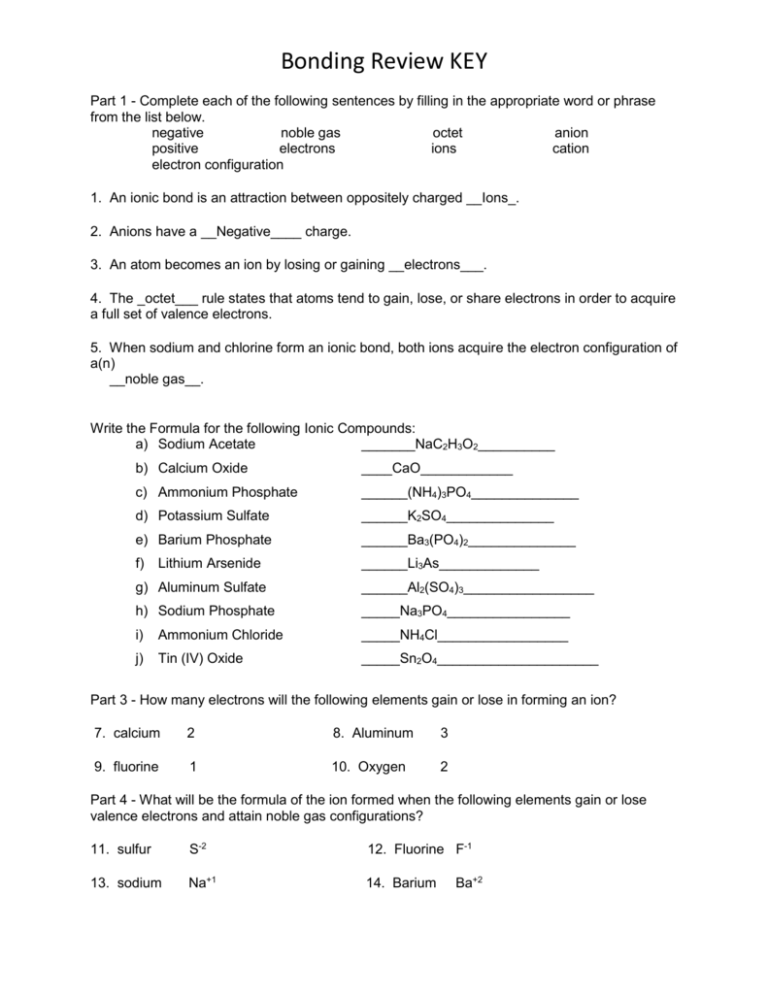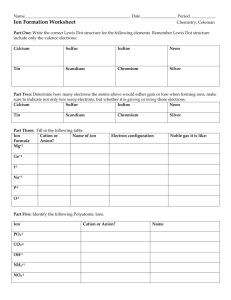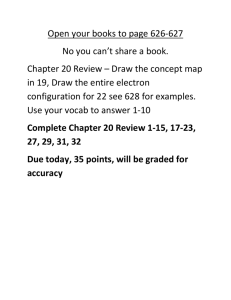Bonding Review (Back Only)
advertisement

Bonding Review KEY Part 1 - Complete each of the following sentences by filling in the appropriate word or phrase from the list below. negative noble gas octet anion positive electrons ions cation electron configuration 1. An ionic bond is an attraction between oppositely charged __Ions_. 2. Anions have a __Negative____ charge. 3. An atom becomes an ion by losing or gaining __electrons___. 4. The _octet___ rule states that atoms tend to gain, lose, or share electrons in order to acquire a full set of valence electrons. 5. When sodium and chlorine form an ionic bond, both ions acquire the electron configuration of a(n) __noble gas__. Write the Formula for the following Ionic Compounds: a) Sodium Acetate _______NaC2H3O2__________ b) Calcium Oxide ____CaO____________ c) Ammonium Phosphate ______(NH4)3PO4______________ d) Potassium Sulfate ______K2SO4______________ e) Barium Phosphate ______Ba3(PO4)2______________ f) ______Li3As_____________ Lithium Arsenide g) Aluminum Sulfate ______Al2(SO4)3_________________ h) Sodium Phosphate _____Na3PO4________________ i) Ammonium Chloride _____NH4Cl_________________ j) Tin (IV) Oxide _____Sn2O4_____________________ Part 3 - How many electrons will the following elements gain or lose in forming an ion? 7. calcium 2 8. Aluminum 3 9. fluorine 1 10. Oxygen 2 Part 4 - What will be the formula of the ion formed when the following elements gain or lose valence electrons and attain noble gas configurations? 11. sulfur S-2 12. Fluorine F-1 13. sodium Na+1 14. Barium Ba+2 Bonding Review KEY 15) NaCl _____Sodium Chloride___________ 16) CuCO3 ____Copper (II) Chloride__________ 17) Ba(OH)2 ____barium hydroxide____________ 18) Sn(HCO3)4 ____tin (IV) bicarbonate ___________ 19) MgCO3 ____magnesium carbonate_________ 20) KF ____potassium fluoride __________ 21) NH4Cl ____ammonium chloride___________ 22) FeO _____iron (II) oxide_________ 23) Be3N2 _____beryllium nitride______________ 24) A cation.,. D a. is a compound composed of two different elements. b. is any atom or group of atoms with a negative charge. c. is a tightly bound group of atoms that behave as a unit and carry a charge. d. is any atom or group of atoms with a positive charge. 25) A metalloid, .. D a) is only group B elements b) is only group A elements c. is composed of a cation and an anion d) has characteristics of both metals and non-metals 26) The Law of Definite Proportions B a), shows the number and kind of atoms present in a molecule of a compound. b), states that in a chemical compound, the elements are always combined in the same proportion by mass. c. shows the kinds and numbers of atoms in the smallest representative unit of the substance, d) only applies to binary compounds Bonding Review KEY 27) Define Polyatomic ion. 28) A binary compound B .a. is a compound composed of two different positive ions. b)is composed of a cation and an anion c, is a tightly bound group of atoms that behave as a unit and carry a charge. d)is the same as a ternary compound 29) A transition element D a). usually forms anions when It reacts. b)is a group A element only c) is the same as a polyatomic ion d) usually can carry more than one charge . 30) The ionic charge of osmium, Os, in the compound Os3P is: E a. 1+ b.1- c.5+ d.3- e. 3+ 31} Which element when combined with chlorine would most likely form an ionic compound? A a) lithium b) carbon c) nitrogen d) fluorine 32) What is the ionic charge of the Aluminum ion in the ionic compound Aluminum oxide (Al2O3) a) +2 b) -2 c) +3 d) -3 C Bonding Review KEY 33) Elements in Group 5A: B a). form positive ions b.) form negative ions c) Do not commonly form ions d. do not react with other element 34) The correct name for Pb3P2 is _____. a. Lead (II) phosphide c. b. Lead (III) phosphide d. A Lead phosphate Lead (III) phosphate 35) The correct formula for iron (III) chlorate is __________. a. FeCl3 b. Fe3Cl c. Fe(ClO3)3 d. FeClO3 e. Fe3ClO3 C 36) Based on its location in the periodic table of elements, you could assume that _______________ is the most reactive metal. C a. helium c. sodium b. iron (III) d. calcium 37) As you move from calcium to bromine, the atomic radii will __________. a. increase b. decrease c. A stay the same 38) An atom with 55 protons, 78 neutrons and 55 electrons will tend to do which of the following during a chemical reaction? C a. lose 5 electrons d) gain 1 electron b. lose 5 protons e) loose 1 electron c. lose 1 electron Bonding Review KEY 39) Based on its location on the periodic table, one could infer which of the following elements is very unreactive? D a. calcium c. silicon b. potassium d. argon 40) Define the octet rule. 41) In what region of the periodic table are electrons being added to the d sublevel as atomic number increases? D a. alkali metals c. transition elements b. actinoids d. metalloids 42) What gains electrons to form negative ions. a. water c. nonmetals b. families d. Metals C





